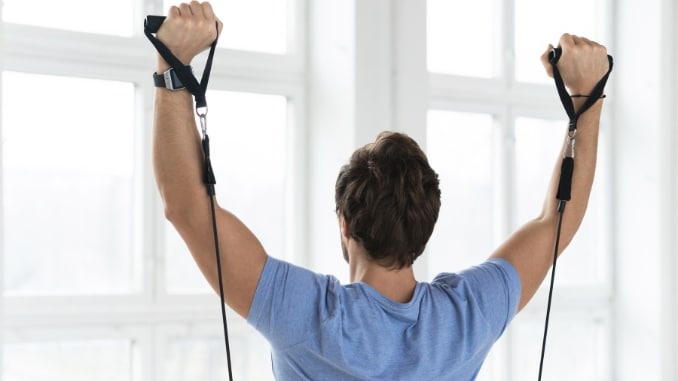
Ever find it tough to stick to a workout routine when you don’t have easy access to equipment? Yeah, I’ve totally been there. Staying consistent feels impossible when gyms aren’t an option, but that’s where finding simple alternatives, like a Resistance Band Arm Workout, can make all the difference.
One of my go-tos? Resistance bands—they’re affordable, portable, and surprisingly effective. Plus, you can use them literally anywhere.
What I love most about resistance bands is how versatile they are.
My goal is to build strength, tone my muscles, and improve flexibility, and these bands have made it so much easier. They’re also a game-changer for building endurance and perfect for injury recovery since they let you exercise gently without overdoing it.
As per Dr. Jo, a Doctor of Physical Therapy, “A great way to rehab your shoulder is to do exercises with a resistive band. They come in many different colors, so make sure the one you have is the right resistance for you. They can be used if you have been diagnosed with shoulder tendonitis, bursitis, adhesive capsulitis, frozen shoulder, shoulder impingement, or if you are recovering from a surgery.”
No gym, no problem—you can work out at home, outside, or even on vacation. Think these could fit into your routine?
Warp up: Resistance Band Arm Exercises
1. Shoulder Rolls
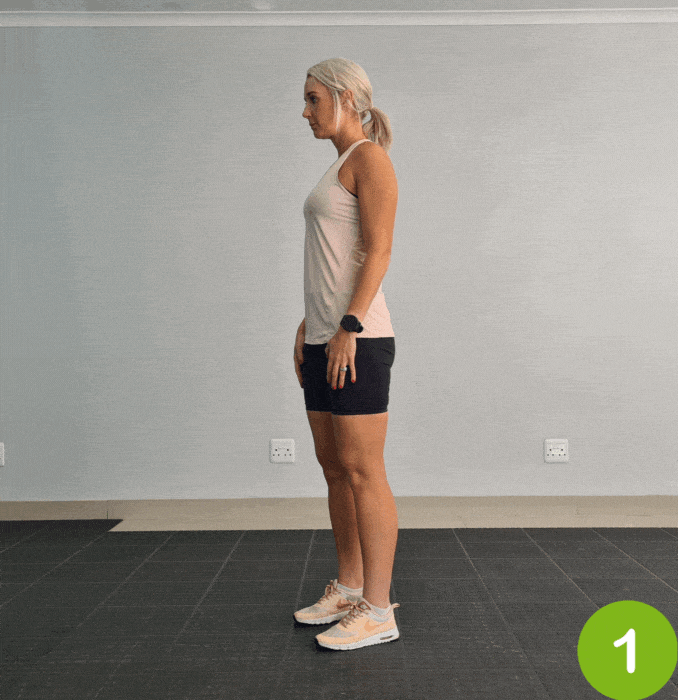
- Begin this Resistance Band Arm Workout in an upright standing position with your feet hip-width apart, maintaining good alignment with your head, shoulders, hips, and legs.
- Place your arms at your sides.
- Engage your core.
- Lift your shoulders, then roll them up and back until you feel resistance in your shoulder blades.
- Lower your shoulders to the starting position and repeat the movement.
- Start with 10 repetitions in each direction.
2. Standing Twist
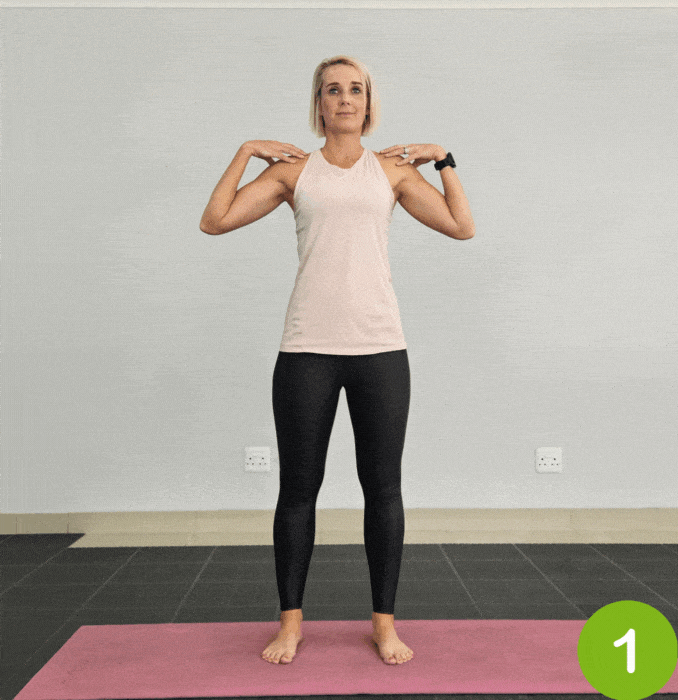
- Begin in an upright standing position with your feet hip-width apart, maintaining good alignment with your head, shoulders, hips, and legs.
- Place your arms at your sides.
- Engage your core.
- Lift your shoulders, then roll them up and back until you feel resistance in your shoulder blades.
- Lower your shoulders to the starting position and repeat the movement.
- Start with 10 repetitions in each direction.
Routine: Resistance Band Arm Exercises
1. Shoulder Sweeps
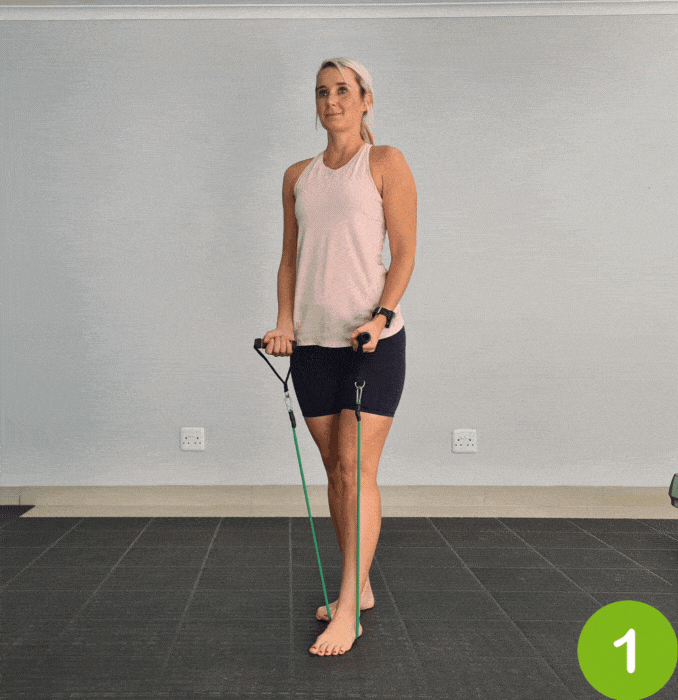
- Begin this Resistance Band Arm Workout in an upright standing position with your feet hip-width apart, maintaining good alignment with your head, shoulders, hips, and legs.
- Stagger your feet, step on the center of the band with your front foot, and hold the ends of the tubing in each hand with your palms facing outward.
- Engage your core and keep a slight bend in your elbows as you lift both arms to head height, creating resistance on the band.
- Lower your arms to the starting position and repeat the movement. Start with 1 set of 10 repetitions.
2. Upright Rows
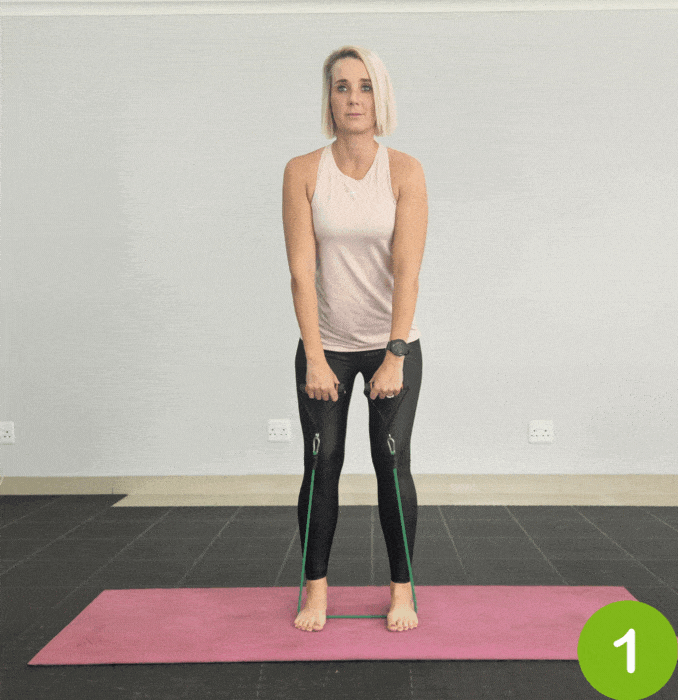
- Begin in an upright standing position with your feet hip-width apart, maintaining good alignment with your head, shoulders, hips, and legs.
- Step on the center of the band with both feet and hold the ends of the tubing in each hand with your palms facing inward.
- Hinge through your hips to bend your upper body forward as you lower your hands to the floor.
- Engage your core and pull the handles up to chest height, bending your elbows out at your sides, ideally to be parallel to the floor.
- Lower your arms to the starting position and repeat the movement. Start with 1 set of 10 repetitions.
3. Bicep Curls
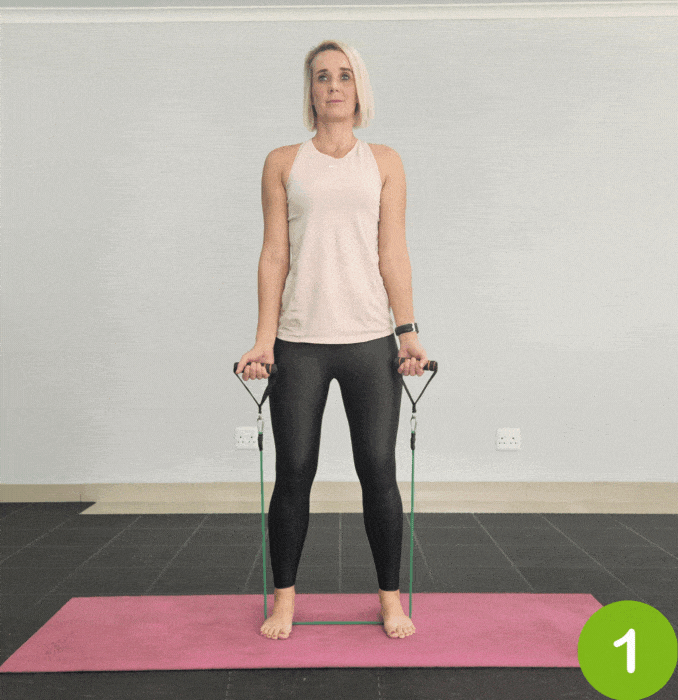
- Begin this Resistance Band Arm Workout in an upright standing position with your feet hip-width apart, maintaining good alignment with your head, shoulders, hips, and legs.
- Step on the center of the band with both feet and hold the ends of the tubing in each hand with your palms facing outward.
- Engage your core and bend your arms to bring the tubing handles to shoulder height.
- Keep your upper arms aligned with your body.
- Lower your arms to the starting position and repeat the movement.
- Start with 1 set of 10 repetitions.
4. Shoulder Flexion
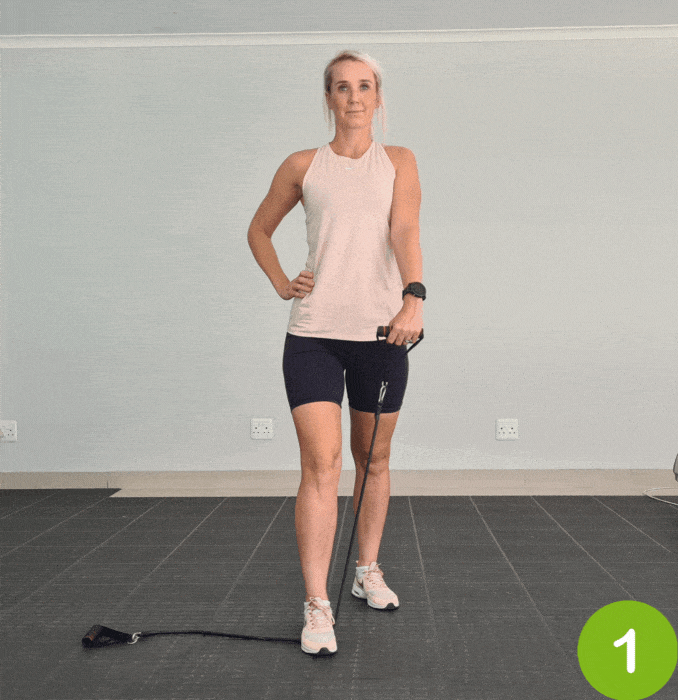
- Begin in an upright standing position with your feet hip-width apart, maintaining good alignment with your head, shoulders, hips, and legs.
- Step on the center of the band with one foot and hold the tubing handle with your opposite hand, your palm facing downward.
- Engage your core and lift your arm, ideally to shoulder level, creating resistance on the band.
- Lower your arm to return to the starting position and repeat the movement.
- After several repetitions, perform the movement on the opposite side.
- Complete 10 repetitions on each side.
5. External Shoulder Rotations
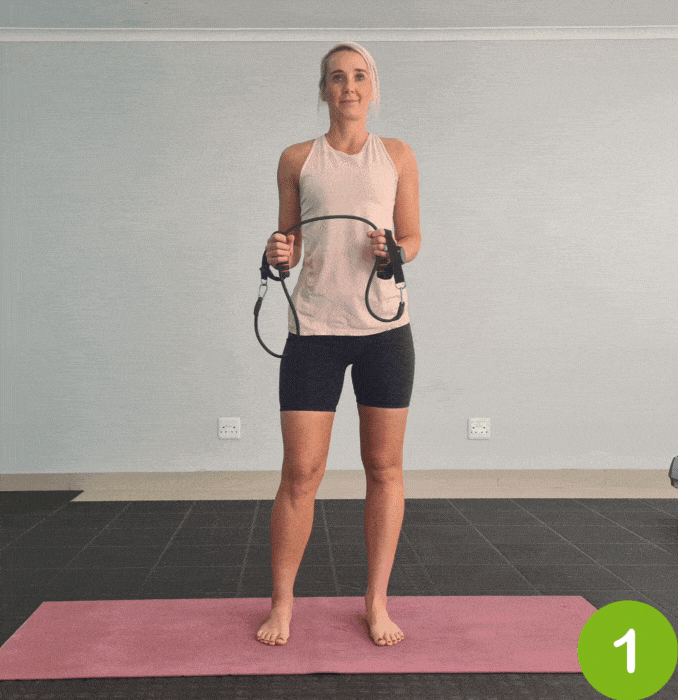
- Begin this Resistance Band Arm Workout in an upright standing position with your feet hip-width apart, maintaining good alignment with your head, shoulders, hips, and legs.
- Bend your arms in front of your body.
- Hold the middle of the resistance band with both hands at chest height, your palms facing inward.
- Tighten your core and rotate one arm out to the side, creating resistance on the band while keeping your elbow close to your upper body.
- Rotate your arm back to the starting position and repeat the movement.
- Start with 1 set of 10 repetitions on each side.
6. Tricep Extensions
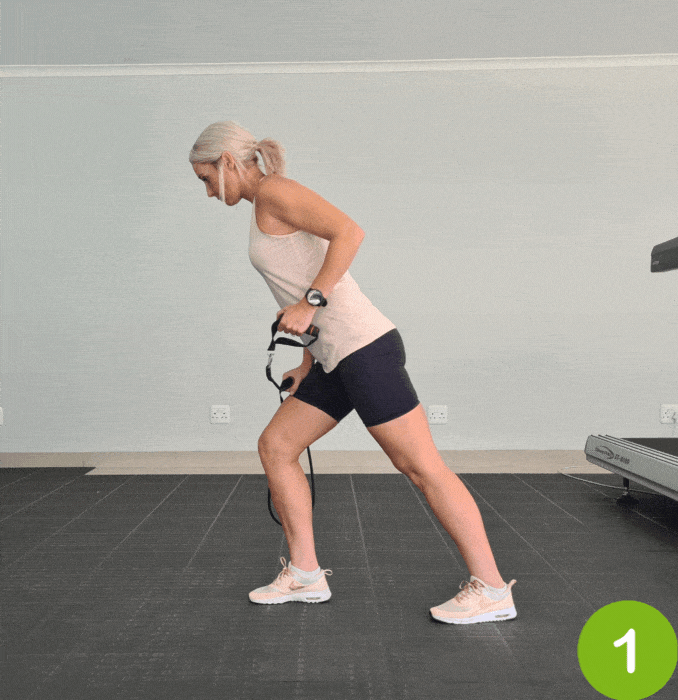
- Begin in an upright standing position with your feet hip-width apart, maintaining good alignment with your head, shoulders, hips, and legs.
- Step one foot forward, then bend your front knee and hinge through your hips to lean your upper body forward.
- Hold the middle of the resistance band in one hand and anchor it against your front knee, holding the end of the band with your opposite hand.
- Contract your core and straighten your upper arm, extending it back slightly past your hips and creating resistance on the band.
- Return to the starting position and repeat the movement.
- Start with 1 set of 10 repetitions on each side.
Resistance Band Exercises For Strong Arms
1. Overhead Resistance Band Stretch
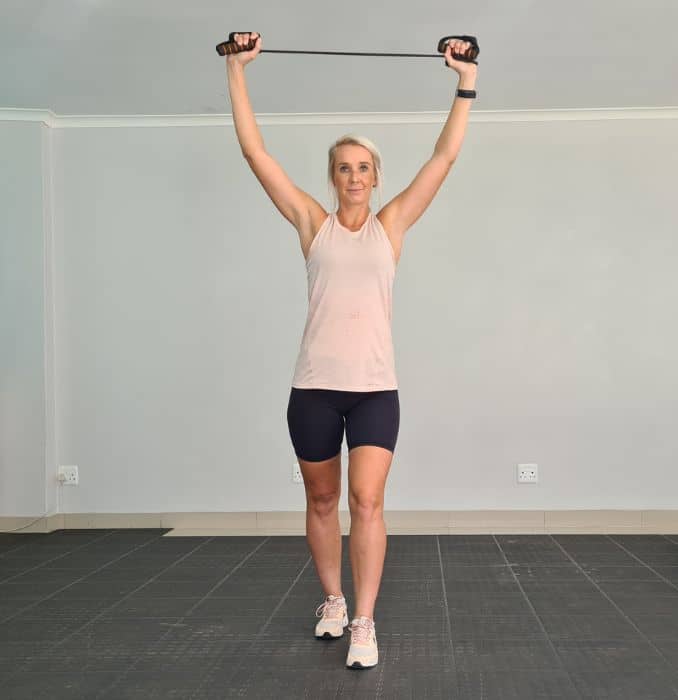
- Begin in an upright standing position with your feet shoulder-width apart.
- Hold a resistance band with both hands, positioning your hands wider than shoulder-width apart on the band.
- Raise your arms straight overhead and extend them fully.
- Your palms should be facing forward, and the resistance band should have slight tension but not be overly stretched.
- Begin by gently pulling the resistance band upward and slightly backward, creating a stretching sensation in your shoulders and triceps.
- Keep your arms extended and maintain a straight back throughout the stretch.
- Hold the stretched position for 15-30 seconds, feeling the stretch in your shoulders and the back of your arms.
- Repeat for your desired number of repetitions.
2. Seated Resistance Band Biceps
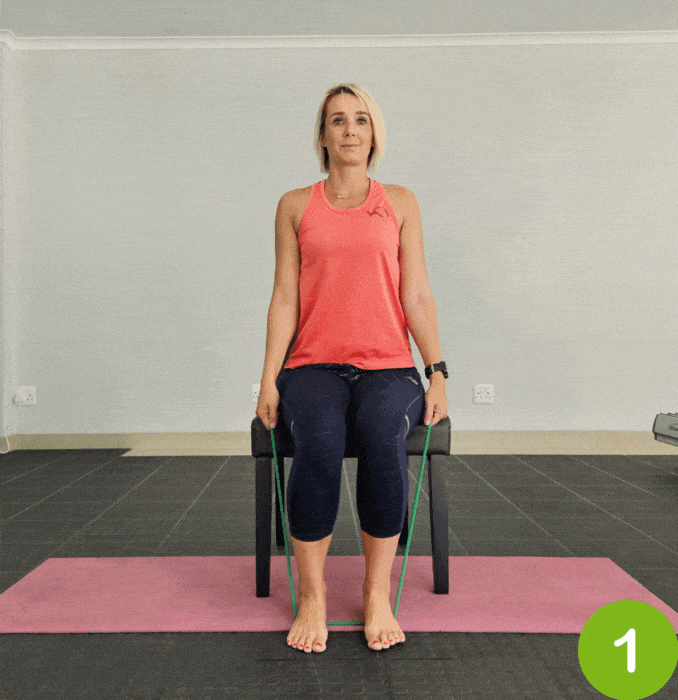
- Sit on a sturdy surface with your back straight and the center of the resistance band under your feet, ensuring it’s secure.
- Hold the end of the band in each hand, palms facing up, and your hands shoulder-width apart.
- Breathe in as you flex your elbows, slowly drawing them towards your shoulders and creating resistance on the band.
- Keep your upper arms still, using only your forearms for the curl as you squeeze your biceps at the top.
- Exhale as you slowly lower your hands, extending your arms without locking your elbows.
- Repeat for your desired number of repetitions.
3. Resistance Band Bent-Over Row
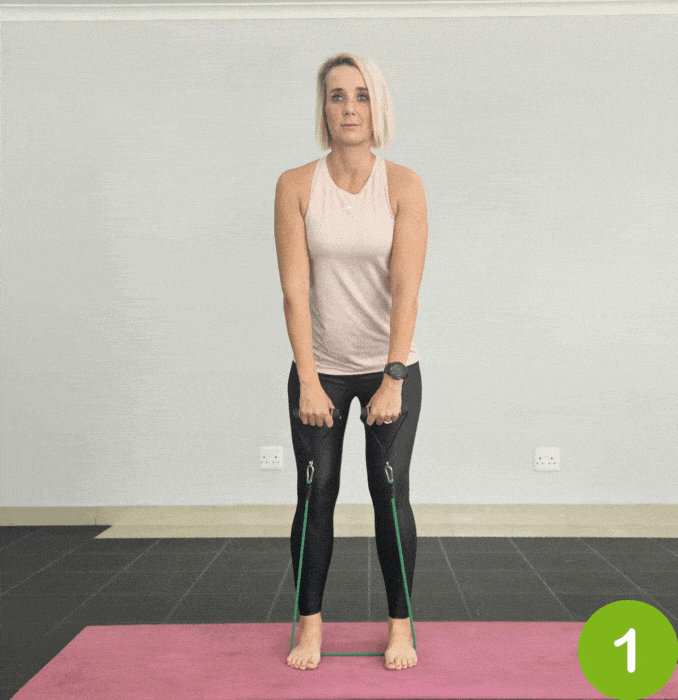
- Stand on the center of the resistance band with feet hip-width apart, ensuring the band is anchored underfoot.
- Hold one end of the band in each hand with your palms facing in and your hands close together.
- With the knees slightly bent, hinge at hips, keeping a straight back, about a 45-degree angle.
- Pull the band towards your lower ribcage, squeezing your shoulder blades together.
- Inhale and return to the starting position.
- Repeat for your desired number of repetitions.
Why Strong Arms Matter (And How They Can Change Your Life)

Building strength in the arms is not just about aesthetics; it’s about functional fitness, injury prevention, athletic prowess, and self-esteem. Incorporating resistance band arm workout into your fitness routine is a wise investment in your overall health and well-being. Here are some benefits of strong arm muscles:
1. Functional Fitness
Strong arm muscles enhance your overall functional fitness. They provide the power and stability necessary for everyday activities such as lifting objects, pushing, pulling, and even maintaining proper posture. Whether it’s carrying groceries, playing sports, or performing household chores, arm strength plays a crucial role in maintaining your independence and preventing injuries.
2. Balanced Physique
Strong arms contribute to a well-balanced physique. A well-developed upper body not only looks impressive but also promotes symmetry and overall muscle tone. It complements the strength and aesthetics of your chest, shoulders, and back, creating a harmonious and attractive appearance.
3. Better Performance In Sports & Activities
Whether you play sports, hit the gym regularly, or just enjoy being active, strong arms can give you a real advantage. They improve your ability to throw, lift, push, and pull, which translates to better performance in activities from weightlifting to recreational sports.
4. Confidence Booster
There’s something empowering about seeing (and feeling) progress in your arm strength. It’s not just about what you can lift—it’s about how you carry yourself. Strong arms can do wonders for your self-esteem, giving you that extra boost of confidence that spills over into other areas of your life.
Creative Home Alternatives For Resistance Bands
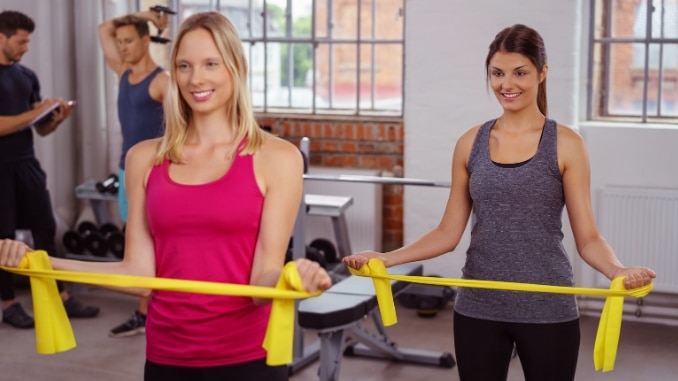
Suppose you don’t have access to resistance bands or are looking for cost-effective alternatives for resistance training [1] at home. In that case, there are several household items and DIY solutions you can use to create resistance.
Here are some home remedies and alternatives for resistance band arm workout:
Water Bottles Or Jugs – Fill empty bottles or milk jugs with water or sand to create makeshift weights. Hold these or attach them to a broomstick for workouts such as bicep curls, shoulder presses, or squats.
Towels – A thick bath towel can be rolled up as an improvised resistance tool. Hold both ends of the towel and use it for exercises like seated rows or chest flies by pulling or pushing against the resistance.
Backpack With Books Or Heavy Objects – Load a backpack with books, canned goods, or other heavy objects to create variable resistance. Wear it while doing bodyweight exercises like squats, lunges, or push-ups to increase the challenge.
Canned Goods – Canned goods provide a convenient and effective option for introducing resistance into your home workouts. They can be used as makeshift weights for various exercises, providing a cost-effective alternative to traditional dumbbells or resistance bands.
DIY Sandbags – Create sandbags by filling old bags (e.g., duffel bags, backpacks) with sand or rice. Use them for squats, lunges, or shoulder presses.
Ties Or Pantyhose – Small, stretchy items like elastic hair ties or pantyhose can be mini resistance bands. Loop them around your ankles or wrists for leg lifts or lateral raises.
Conclusion
In conclusion, resistance band arm workout offers a convenient and effective solution for maintaining a consistent fitness routine, even in the face of obstacles like limited access to exercise equipment. Resistance bands offer a cost-effective, convenient, and secure option, rendering them a perfect selection for those looking to enhance their arm strength and overall fitness.
The importance of having strong arm muscles extends far beyond aesthetics. Strong arms enhance functional fitness [2], ensuring you can tackle everyday tasks with ease and reduce the risk of injuries. They contribute to a balanced physique, improving overall muscle tone and appearance.
Additionally, strong arms can elevate your athletic performance, giving you an advantage in various physical activities. Building arm strength can enhance self-confidence, resulting in a more positive self-perception and an improved sense of well-being, which may be the most significant outcome.
Therefore, incorporating resistance band arm workout into your fitness routine is a wise investment in your physical and mental health, helping you lead a healthier, happier life.
It’s time to start collecting those flattering sleeveless tops that you’ve always been coveting. Say goodbye to those flabby arms forever, and say hello to the sleek, sexy arms that you’ve always wanted. Check out this Tone and Tighten Arm Workout!
FAQs
1. Can resistance bands really build muscle like weights?
Absolutely! Resistance bands provide consistent tension throughout each movement, targeting muscles effectively. While they may feel different from traditional weights, they’re great for building strength, toning muscles, and increasing endurance.
2. How often should I do resistance band arm workouts?
For best results, aim for 2-3 sessions per week. This gives your muscles time to recover while allowing you to build strength gradually. Combine your arm workout with other exercises for a well-rounded routine.
3. Are resistance bands effective for injury recovery?
Yes! Resistance bands allow controlled movements with adjustable resistance, making them ideal for gentle exercises during rehab. They help rebuild strength without putting too much strain on injured muscles or joints.
4. What if my resistance band workout feels too easy?
If it feels too easy, try shortening the band, increasing repetitions, or using a heavier resistance band. You can also add compound movements, like squats or lunges, to increase the intensity.

